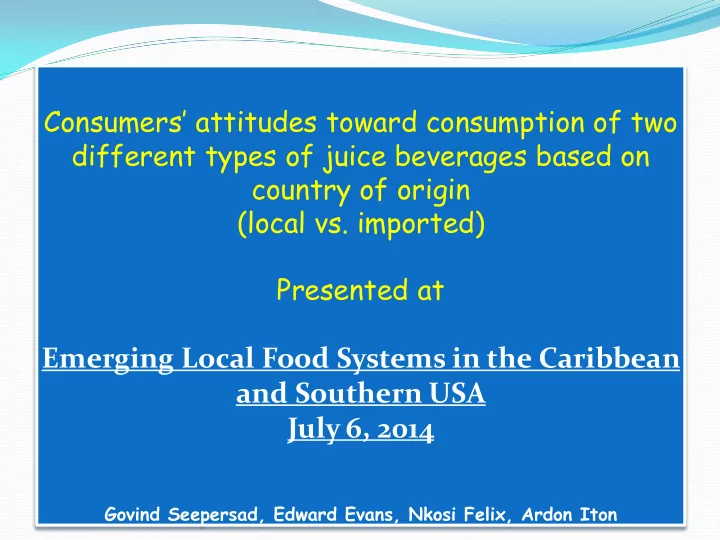

Consumers ’ attitudes toward consumption of two different types of juice beverages based on country of origin (local vs. imported) Presented at Emerging Local Food Systems in the Caribbean and Southern USA July 6, 2014 Govind Seepersad, Edward Evans, Nkosi Felix, Ardon Iton
• Significant changes are taking place in food and agricultural markets. • Advances in transportation, post- harvest technologies and trade agreements have virtually transformed the world into a single global village.
In the Caribbean region, there has been a steady increase in the importation of fruit juices to meet shortfalls in domestic supply. This takes place although many tropical fruits can be produced for juice given the favorable year-round climatic conditions that exist in the region.
Moreover there exists an increasing amount of agricultural lands available, due in part to the erosion of preferential markets for traditional crops such as sugar and bananas. Much of these lands are of high quality and, in most cases, are suitable for orchard cultivation. Yet despite the situation, the region continues to import large quantities of fruit juices.
Import volumes of HS 2009 (Fruit & Vegetables juices unfermented) was 59,000 tons in 2012, valued at US$84 million in 2012
This study was conducted to determine consumers’ attitudes toward consumption of two different types of juice beverages based on country of origin or local vs. imported.
1. to determine the drivers behind the growing consumer preference for juices and whether source of origin was an important factor.
It was hypothesized that source of origin (import 1. vs local) will be significant based on age of respondents and the younger population will be less concerned about origin. (We thought that the importance of “origin” will be of diminishing importance given the advent of globalization, online e-commerce etc (i.e., whether the product was locally made or imported). Thus, age would be a significant factor in the determination of origin of the product.
Definition For this study, juice is defined as any fruit- based beverage intended for direct consumption. In the Trinidad and Tobago market, juice beverages available for direct consumption include “ juice drinks ” and “ juice beverages ”, both of which may contain 10% to 20% fruit juice.
Data were collected using a structured questionnaire 1. across a random set of consumers in Trinidad and Tobago. A total of 200 questionnaires were enumerated. 2. The study used Point Score (PS) analysis 3. Chi-Square cross tabulation to analyze the results. 4. Regression analysis was also used to determine the 5. relationship between attributes.
Juices Used in the Study
Label (level of Value used for importance) analysis Very important 5 Important 4 Neutral 3 Little importance 2 Unimportant 1
The point score of each variable is calculated by the summation of the values selected multiplied by the number of respondents that choose the respective value. This formula is shown below: Point score = Ʃ (i*w i ) ………………….…………….............. (1) where, i = value from chosen for level of impact…i = 1, 2, 3, 4 or 5 w = Number of respondents that choose the respective ‘i’
This model quantifies categorical data through numerical assignment. The estimated coefficients of this model reflect how changes in the predictors affect the response. The use of this model allows the relationship between a dependent variable and categorical independent variables.
Y = choice between imported or locally made juice products and, Y = the willingness to pay for imported juice or local juice.
X 1-9 = importance of juice product attributes of packaging, • labeling, • availability, • price, • taste, • appearance, • experience, • safety, and • health. •
Results Demographics The majority (72.5%) of respondents preferred locally made juice as compared to imported juices, with a larger percentage of females being regular consumers of juice drinks (Chi=15.133, p value=0.004). The study also revealed that age of an individual and his/her highest educational level did not influence the consumption of juice.
Results Demographics – Local Juice The preference for local juice was supported by the prices that respondents were willing to pay: 66% were willing to pay between $5 and $8, 23.7% were willing to pay $4 and lower 10% were willing to pay between $9 and $15.
Results Demographics – Imported Juice In contrast, more (97.9%) respondents were willing to pay $8 and lower for imported juice and only 2.1% were willing to pay between $9 and $12.
Results • respondents considered all the factors presented to be very important in their purchase decision
Ranking of Importance using Point Score Analysis Product “ taste ” was ranked number one with a score of 886, “ Safety ” was second with a score of 834. “ Price ” paid was ranked at number 4 th among the attributes.
Ranking of Importance using Point Score Analysis It should be noted that “ availability ” and “packaging” of juice received the lowest rankings among the attributes.
Point Score Analysis This analysis showed that consumers were more interested in the “ taste ” and “ price ” of juice as compared to the “ health benefits ” derived from its consumption.
Regression analysis: Disaggregation of factors which influence the consumption of local and imported juice There were only two attributes found to be statistically significant that influenced the price consumers were willing to pay.
Regression analysis: Disaggregation of factors which influence the consumption of local and imported juice Imported Juice (source of origin) (i) Dependent variable - A significant but negative relationship was found between the price of the imported juice product and consumers’ willingness to pay.
Regression analysis: Disaggregation of factors which influence the consumption of local and imported juice Local Juice (source of origin) (i) Dependent variable - Taste and the experience of consuming these juices were significant. (ii) These attributes had a positive relationship with willingness to pay .
Age of Respondents was not found to be significant
Thank You
Recommend
More recommend